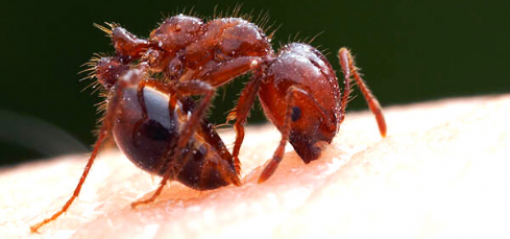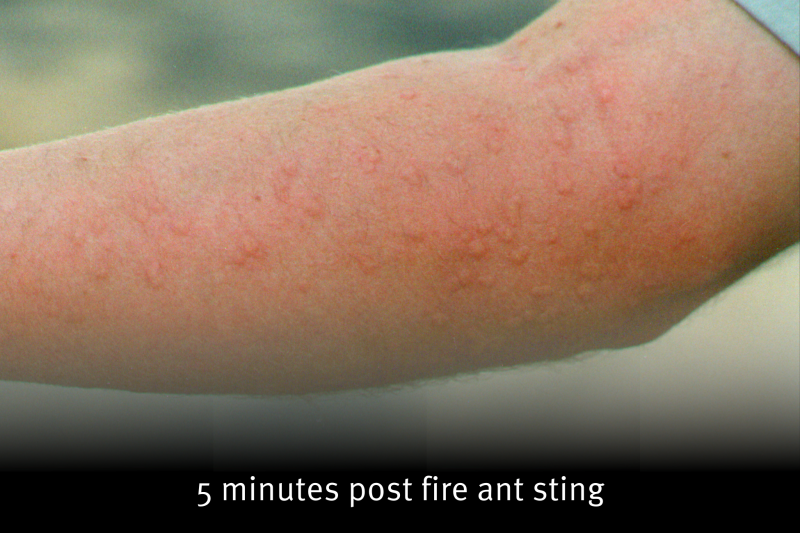Encounters with fire ants can involve tens or hundreds of ants. They tend to swarm and all sting at once, repeatedly.
The pain of a fire ant sting can last up to an hour.
On this page

How to identify a fire ant sting
Fire ant stings are painful, and can cause:
- a severe burning or fiery sensation
- swelling
- redness.
Why fire ant stings are different
Unlike other insect stings, fire ant venom builds up in the body. This means the more you, your pet or an animal is stung the greater the risk of an extreme reaction.
In this video, a National Geographic TV host shows us what happens when he's stung by fire ants.
Video courtesy of National Geographic
I'm about to enter a world of pain.
These are Brazilian fire ants. You can see them around my big toe—they're tiny but excruciatingly painful. They're called fire ants for a reason. It doesn’t so much feel like being bitten as being set on fire.
First, they bite you with their mandibles, which are barbed—that's the first thing you feel. Then they arch their backs over and sting you with a very powerful alkaloid venom. It feels like I'm on fire.
These ants are so tiny and well hidden in the grass. You're just walking along, put your foot down on what looks like an ordinary patch of ground, and within minutes, they swarm you.
I don't know why you're laughing—they're up your leg too!
It's the female worker ants that sting, and their complex venom can cause severe reactions in some people. In rare cases, even death. One reason why these stings are so painful is that when one ant grabs you, it won’t just sting once—it’ll sting repeatedly, even after its venom bladder is empty.
Oh, that was painful. Look at that blister coming up.
To avoid being bitten by these guys, don’t wear what I’m wearing—sandals. Preferably, wear boots. Most importantly, watch where you step. Tuck your pants into your socks and be aware that these ants are incredibly hard to spot. You’ll regret stepping on them.
The fire ant venom is now taking its toll, and I’m struggling to walk. My body is showing warning signs—I need to find a hospital, quickly.
Okay, okay.
Morning, right? Yeah, yeah.
I thought these fire ants would just burn and hurt a bit. But this is a serious reaction to a fire ant sting.
For a start, look at my arms—they’re covered in what looks like warts. Can you see it spreading? Huge blisters. My lips are swelling, my heart is racing. Look at my left eye—it’s starting to close because my eyelid is so swollen. I can feel my tongue swelling as well.
My heartbeat is going really fast. You can't see that, but I’m also struggling to breathe. So yeah, I think the next stop is medical attention. Do we have any powerful antihistamines close by?
My film crew—now my lifeline—rushes me to the nearest hospital as I struggle for breath. The clock is ticking.
To my horror, I realise I’m now one of those rare cases of people who have life-threatening reactions to fire ants. The bites have triggered dangerous levels of histamines, and my blood pressure is dropping fast. I’m experiencing anaphylactic shock—my body is hypersensitive to the venom.
The medical team acts fast, administering a life-saving combination of adrenaline and steroids to counter the reaction. Slowly, I begin to recover.
I feel all right now, lying down. If I hadn’t been horizontal, I would have been involuntarily pretty soon.
It’s worth remembering—this could have happened in the middle of nowhere. For me, it happened close to a good hospital. But if you’re travelling or off the beaten track, you really don’t want to mess around with ants, no matter how small or harmless they look.
Thanks to the doctors and nurses, I live to fight another day.
Photos of fire ant stings
After a few hours (or even a day or two), small blisters or pustules may form at sting sites. These may become itchy and can take up to 10 days to heal.
Photos courtesy of Alex Wild







